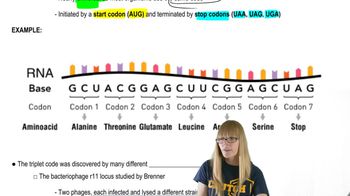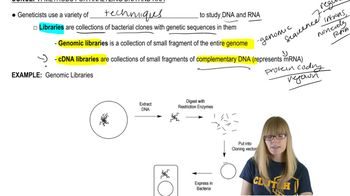Table of contents
- 1. Introduction to Genetics51m
- 2. Mendel's Laws of Inheritance3h 37m
- 3. Extensions to Mendelian Inheritance2h 41m
- 4. Genetic Mapping and Linkage2h 28m
- 5. Genetics of Bacteria and Viruses1h 21m
- 6. Chromosomal Variation1h 48m
- 7. DNA and Chromosome Structure56m
- 8. DNA Replication1h 10m
- 9. Mitosis and Meiosis1h 34m
- 10. Transcription1h 0m
- 11. Translation58m
- 12. Gene Regulation in Prokaryotes1h 19m
- 13. Gene Regulation in Eukaryotes44m
- 14. Genetic Control of Development44m
- 15. Genomes and Genomics1h 50m
- 16. Transposable Elements47m
- 17. Mutation, Repair, and Recombination1h 6m
- 18. Molecular Genetic Tools19m
- 19. Cancer Genetics29m
- 20. Quantitative Genetics1h 26m
- 21. Population Genetics50m
- 22. Evolutionary Genetics29m
18. Molecular Genetic Tools
Methods for Analyzing DNA
Problem 41b
Textbook Question
The two gels illustrated contain dideoxynucleotide DNA-sequencing information for a wild-type segment and mutant segment of DNA corresponding to the N-terminal end of a protein. The start codon and the next five codons are sequenced. Write the DNA sequence of both alleles, including strand polarity.
 Verified step by step guidance
Verified step by step guidance1
<Step 1: Understand the context of the problem. You are given two DNA sequences obtained from dideoxynucleotide sequencing gels, one for a wild-type and one for a mutant segment. These sequences correspond to the N-terminal end of a protein.>
<Step 2: Identify the start codon in the sequence. The start codon for protein synthesis is typically 'ATG' in DNA. Locate this codon in both the wild-type and mutant sequences.>
<Step 3: Determine the directionality of the DNA strands. DNA sequences are typically read from the 5' to 3' direction. Ensure you identify the 5' and 3' ends of the sequences on the gel.>
<Step 4: Transcribe the sequence from the gel. Using the information from the gel, write down the sequence of nucleotides for both the wild-type and mutant alleles, ensuring to include the strand polarity (5' to 3').>
<Step 5: Compare the sequences. Once you have both sequences, compare them to identify any differences between the wild-type and mutant alleles, which may affect the protein's N-terminal end.>
Recommended similar problem, with video answer:
 Verified Solution
Verified SolutionThis video solution was recommended by our tutors as helpful for the problem above
Video duration:
4mPlay a video:
Was this helpful?
Key Concepts
Here are the essential concepts you must grasp in order to answer the question correctly.
Dideoxynucleotide Sequencing
Dideoxynucleotide sequencing, also known as Sanger sequencing, is a method used to determine the nucleotide sequence of DNA. It involves incorporating dideoxynucleotides, which terminate DNA strand elongation, allowing for the generation of fragments of varying lengths. By analyzing these fragments through gel electrophoresis, researchers can deduce the sequence of the original DNA strand based on the size of the fragments.
Recommended video:
Guided course

Sanger Sequencing
Codons and Genetic Code
Codons are sequences of three nucleotides in DNA or RNA that correspond to specific amino acids or stop signals during protein synthesis. The genetic code is universal and dictates how sequences of nucleotides are translated into proteins. Understanding codons is essential for interpreting the DNA sequence and predicting the resulting protein structure and function.
Recommended video:
Guided course

The Genetic Code
Strand Polarity
Strand polarity refers to the orientation of the DNA strands, which are antiparallel and have distinct 5' and 3' ends. The 5' end has a phosphate group, while the 3' end has a hydroxyl group. This polarity is crucial for DNA replication and transcription, as enzymes that synthesize DNA and RNA can only add nucleotides to the 3' end of a growing strand, influencing how sequences are read and written.
Recommended video:
Guided course

Double Strand Breaks

 7:40m
7:40mWatch next
Master Methods for Analyzing DNA and RNA with a bite sized video explanation from Kylia Goodner
Start learningRelated Videos
Related Practice


